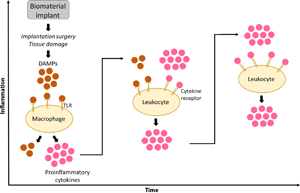Article contents
The role of Toll-like receptor signaling in the macrophage response to implanted materials
Published online by Cambridge University Press: 06 December 2019
Abstract

Inflammation is facilitated largely by macrophages and other white blood cells, which recognize and respond to evolutionarily conserved damage-associated molecular patterns that are released upon tissue injury and cell stress. Damage-associated molecular patterns are known to bind Toll-like receptors (TLRs) and initiate inflammatory responses through MyD88-dependent NF-κB signaling. Biomaterial implantation activates the innate immune system, resulting in a chronic inflammatory response known as a foreign body reaction (FBR). In this review, the authors discuss the current understanding of damage-initiated TLR signaling in the FBR and the significance of this response in the success of implanted devices.
- Type
- Prospective Articles
- Information
- Copyright
- Copyright © Materials Research Society 2019
References
- 7
- Cited by





